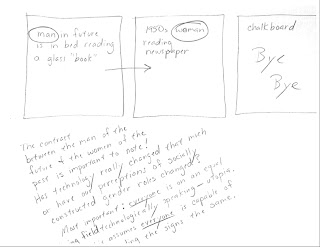Last night's discussion of Lanham and the issue of originality in one's work really got the rusty wheels turning. In fact, it has stopped me in my tracks. What does this mean for future authors/creators? I had to ask myself if I have succumbed to the sloth-like tentacles of apathy and have relinquished any and all creative originality in favor of revamping old works and presenting them instead as a polished, stylistic uniqueness that is "mine, all mine" (read in your best Stewie voice). I feel the music world, like shaking the plastic, answer-filled, eight-ball, provides us with all of life's daunting and seemingly unanswerable questions. What does the music world contend is the future of originality? Let's shake it and see!
When ADELE hit the boob-tube several years ago with her single "Chasing Pavements", she exploded onto the scene with a whole new look (not starving, stick-insect, model-type who needs to eat a boatload of Twinkies) and a whole new voice (Etta James kicks the s@*t out of The Cure and steals their vibes). Considering I am able to make any connections to past works/artists, is ADELE original?
What about pop icons such as Madonna and Michael Jackson? Historically speaking, they are considered two of the most original musical talents to have ever graced the pages of Rolling Stone mag. Madonna has tirelessly reinvented herself over-and-over to represent the current goings-on in her personal life as well as mimic any social movements that might be taking place at that time. Ranging from angsty teen to earth mother to hip hop, digital pimp-ess, Madonna has run the gambit expanding the musical world and moulding it into her creative playground.
Michael Jackson provided listeners and viewers with a completely different perspective of rock music. He journeyed deep into the introspective locales of his mind to bring his fans a level of creativity that continues to puzzle critics and pushes the boundaries of musical talent. Theatrical in nature, Jackson's videos and music bring a unique element to the table. But what about singer/songwriters such as Bjork who also create theatrical works? Who is the original?
Let's shake the musical ball once more. Fast-forward to the current episode of American Idol, which ironically has Steven Tyler sitting in as one of the judges. Phillip Phillips (damn his parents!) is not crazy good but kuh-ray-zee good! I am pretty sure his mother belongs in the Guinness Book of World records since she gave birth to him and his guitar. His stage presence commands respect as do his voice and appendage-like guitar. From the moment he steps onto stage, grips the mic, and opens his mouth--your ass belongs to Phillips as well as your soul. If I were a DJ playing any number of his tunes, I would be thankful that radio is an auditory medium only because I would jump outta my seat sending my chair flying across the room and dance until I look like I just competed in a Flash Dance contest (minus the horrible leg warmers and head band). Phillips is what happens when Dave Matthews and James Brown are tossed into a musical blender and poured into a glass served to Tom Waits who then responds, "Hot damn! Papa's Got A Brand New Bag!"
Indeed he does.
Let's ponder once more the notion of originality. Does it exist? Or like a song that has been remade 3,000 times too many (thank you Beatles for "Yesterday") are artists/authors left to build their creativity on an already established foundation? To answer this question, I leave you with this song...










